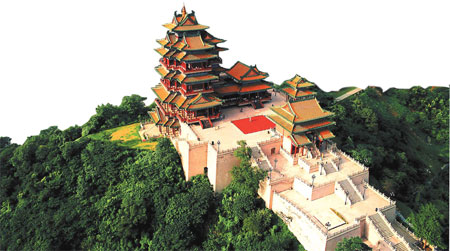|

|
|
Yuejiang Tower sits on the Lion Hill in the northwest part of Nanjing, near the banks of the Yangtze River. |
"It is hard to find another city like this," said Dr Sun Yat-sen as he gazed over Nanjing, The city is one of China's Four Great Ancient Capitals and was much-loved by Sun, the 20th century revolutionary and politician still seen by many as "the Father of Modern China".
It is fitting that his mausoleum now lies in the city of which he once famously wrote: "The setting of Nanjing is wonderful. Mountains, lakes and plains all abound here." However, the contemporary and historical significance of this great city extend well beyond the patronage of one historical figure.
Located in the lower Yangtze River basin and the Yangtze River Delta economic zone, Nanjing was China's capital city across six ancient dynasties and today serves as the capital of Jiangsu province. It also retains its historical role as one of the countries most important hubs for education, research, transportation and, of course, tourism.
Modern-day Nanjing spans a total of 6,598 square kilometers and has more than 7.4 million permanent residents, with more than 75 percent of them now officially classed as urban dwellers.
Its setting at the prime intersection of the Yangtze River with many of the traditional overland transportation routes has seen it established as a key transfer point between the east-west waterways and the north-south road and rail networks.
Nanjing is the second largest commercial center in Eastern China after Shanghai. Recent years have seen substantial investment in the city's economy, commerce, industry and infrastructure. This investment has seen the city's GDP rise to $6,000 per head of population, whilst its technical competence and resource now puts it in the top 10 of all mainland cities.
This 21st century transformation of the city was recently acknowledged by Forbes, the authoritative US business magazine. It was singled out as both "one of the most promising cities in the Asia-Pacific and "one of the top three commercial cities in the Chinese mainland".
Geographical advantage
Nanjing is the most important transportation hub in eastern China and the downstream Yangtze River area. The city boasts and advanced integrated public transport network offering a vital link between land, air and waterway services.
The Nanjing Lukou International Airport is one of the 10 largest in China and has a large number of regular passenger and cargo flights to international destinations, including London, Frankfurt, Amsterdam, Vancouver, Los Angeles, Chicago, Moscow, Tokyo, Singapore and Seoul. In total, some 140 airlines operate services to and from the city.
The city's harbor is the largest inland harbor in Asia and services some 200 ports in 80 different countries and regions.
A historic and cultural city
The earliest signs of civilizations in the Nanjing area date back more than 6,000 years, with the city itself established 2,500 years ago. During its long history, the city has served 10 dynasties and regimes as the country's national capital.
It last served in this role during the years of the Republic of China (1912-1949) when the role was again ceded to Beijing. Its long historical associations have left the modern city with a rich legacy of antique artifacts and cultural treasures.
Climate and environment
Nanjing implemented an "urban green space" policy in 2003 and has now completed nearly half of its ambitious tree-planting initiative. This initiative has seen the city's green area rise to 12 square meters per head of population.
Its eco-friendly progress has seen the city widely honored as a model of sustainable development. It has been recognized as "The National Park City of the Year", "The National Urban Hygiene Awards" and as a model city by both the National Environmental Protection agency and the National Afforestation agency.
Its status as one of the Chinese cities with the highest standard of living has been enhanced by its low crime rate and high reputation for public security.
In terms of weather, Nanjing falls within the northern subtropical monsoon climate zone and enjoys four seasons with plentiful sunshine and rains. The average temperature is 17.8C and the annual amount of rainfall is 1,034 mm.
(China Daily February 27, 2009)